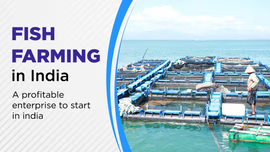Aquaculture Farming in India: Meaning, Importance and Benefits

Aquaculture is an effective approach for cultivating aquatic organisms in a controlled manner. India is the world's second-largest aquaculture nation and fish producing country with around 8% share in global fish production. India has considerably increased its aquaculture production, mainly in relation to shrimps and freshwater fishes. Today’s blog explores the importance of aquaculture farming in India along with its types and benefits.
Table of Contents
- What is Aquaculture?
- What is the Status of Aquaculture in India 2025?
- What are the Types of Aquacultures?
- What is the Importance of Aquaculture in India?
- What are the Benefits of Aquaculture in India?
- What are the Government Initiatives to Boost Aquaculture in India?
- A Way Forward to India’s Aquaculture Development
What is Aquaculture?
The farming of aquatic organisms like molluscs, aquatic plants, crustaceans and fish is called aquaculture. It involves the farming of aquatic plants and animals that are economically important under controlled conditions. It is also known as aqua farming and involves breeding, rearing and harvesting of saltwater and freshwater populations in controlled conditions. The most common practice of aquaculture is fish farming. Examples of aquaculture fish are Catfish, Milkfish, Seabass and Grouper. The Blue Revolution scheme has helped increase aquaculture production and fisheries production in India using multi-dimensional activities.
What is the Status of Aquaculture in India 2025?
India ranks second in aquaculture production and is amongst the biggest global supplier of shrimp. It is the second largest fish producing country with around 8% share in global fish production. The India aquaculture market size reached 14.4 million tons in 2024. Seafood exports are valued at Rs. 60,000 Crores.
The period from 2004 to 2024 has been transformative for India in global fisheries and aquaculture. The Union Budget 2025-26 proposed the highest ever total annual budgetary support of Rs. 2,703.67 crores for the fisheries sector.
The budget enabling a framework for sustainable harnessing of fisheries from Exclusive Economic Zone (EEZ) and High Seas with special focus on Lakshadweep and A&N Islands.
The government of India has also increased Kisan Credit Card (KCC) lending limit from Rs. 3 lakhs to Rs. 5 lakhs to enhance credit accessibility for fishers, farmers, processors and other fisheries’ stakeholder.
Shrimp is cultured in around 0.16 million hectares presently. The key producers of shrimp are West Bengal and Andhra Pradesh. They account for around 80% of the total production in India.
What are the Types of Aquacultures?
Marine aquaculture, freshwater aquaculture and brackish water aquaculture are the different aquaculture systems. Let’s discuss all types of aquacultures in more detail.
Freshwater Aquaculture
Freshwater aquaculture includes ornamental fish farming, freshwater pearl culture, and breeding freshwater fish such as magur, rohu, catla, carp, and freshwater prawns. Rajasthan and Uttar Pradesh grow catla in reservoirs and tanks. Freshwater farming is done using zero saline water.
Inland waters contribute to about 70% of India's total fish production. Around 65% of this is obtained from aquaculture. Some 1300 Carp Hatcheries produce supplies and seeds for fish farmers. Major carp is the leading cultured freshwater fish. It is followed by:
- Exotic carps
- Minor carps
- Catfish
- Trout
The Indian inland fisheries can be categorised as:
- Culture Fisheries (Aquaculture)
- Sport Fisheries
- Ornamental Fisheries
- Coldwater Fisheries
- Floodplain and Wetland Fisheries
- Estuarine Fisheries: Estuaries & Backwaters
- Riverine Fisheries: Rivers & Streams
- Lacustrine Fisheries: Lakes & Reservoirs
Brackishwater Aquaculture
Brackish water aquaculture is the breeding of fish belonging to the sea habitat, such as mud crabs, tiger shrimp, grey mullet and sea bass. It is common in states such as Goa, Kerala, Andhra Pradesh, and West Bengal. A mix of mussel or clam meat, locally available snail, rice bran and oil cakes are used by fish farmers to feed the fish. Around 1.2 million hectares of brackishwater resources are available in India. They include mangrove plants, mudflats, tidal creeks, backwaters, lakes, coastal lagoons and estuaries.
Mariculture
Mariculture involves cultivating marine organisms for several products like food. This specialised branch of aquaculture uses ponds, tanks or enclosed sections of the sea (pens/cages). The long coastline of India stretches along nine maritime states and four union territories.
Exclusive Economic Zone (EEZ) is spread across 2.02 million km2, while the Continental Shelf is 0.53 million km2. EEZ has an annual potential yield of around 3.93 million tonnes of fish. Marine Fisheries is an integral part of the Indian Fisheries Sector.
The key marine fisheries are categorised as:
|
Bottom-water Fish (Demersal) |
Eels, Flatfish, Pomfrets, Catfish, Perches |
|
Mid-water Fish (Pelagic) |
Horse Mackerel, Silver Bellies, Cobia, Bombay Duck |
|
Surface-water Fish (Pelagic) |
Tuna, Seer fish, Mackerel, Ribbonfish, Anchovies, Sardines |
What is the Importance of Aquaculture in India?
Aquaculture plays a key role in addressing several challenges. The importance of aquaculture involves new trade opportunities, livelihood support and economic boost. Let’s have a look at the most important role of aquaculture below:
Meeting Food Demand
The population of India is increasing, and with it, the demand for food, especially protein-rich food, is rising. Seafood is a rich source of protein. Thus, aquaculture can help fulfil this demand plagued by a limited supply of fisheries. It ensures a consistent source of seafood.
Conservation of Threatened Species
Overfishing of threatened species is a major problem in India. It can have serious socioeconomic and ecological consequences. In the marine fish stock assessment, 8.2% of 135 fish stocks were found to be overfished. It included varieties of sharks, groupers, lobsters and croakers.
Aquaculture can take the place of wild harvesting of such species. It is an effective alternative to reduce pressure from wild populations already under stress. This method recovers and maintains their ecological balance.
Economic Growth
Aquaculture has a big contribution to the global and local economy. It generates employment opportunities in rural and coastal communities. At the primary level, the fisheries and aquaculture sector are a source of income for around 2.8 crore fishers and fish farmers. It supports livelihoods for small-scale farmers, processors, distributors and related industries.
Resource Efficiency
The cons of traditional fishing include habitat destruction and unintentional bycatch. Aquaculture systems can be designed to minimise these negative impacts. This makes them a more environmentally friendly option. The benefits of aquaculture include efficient water use, reduced land footprint and controlled waste management.
What are the Benefits of Aquaculture in India?
- One of the main benefits of aquaculture is that it is a growing industry. The Global Aquaculture Market Report (2022) reveals that the aquaculture market will grow at 7.7% CAGR to reach 50.38 billion USD in 2026. Thus, it is an important economic driver that contributes to trade, employment and regional and local economic development.
- Aquaculture has relatively less damaging environmental impacts than other types of livestock farming. Generally, marine aquaculture operations need less land, less water and fewer resources. Also, its carbon footprint is smaller.
- Overfishing can disrupt marine food chains, causing irreversible damage to marine ecosystems. Aquaculture lessens the need for excessive fishing. It allows marine environments to recover and regenerate.
What are the Government Initiatives to Boost Aquaculture in India?
Being rich in resources, India has a huge potential for developing fisheries, generating employment opportunities, earning foreign exchange and strengthening food security. Thus, there are several government schemes to promote fish farming in India.
Major initiatives to expand aquaculture across India include:
Centrally Sponsored Scheme
During the 10th Plan, a Centrally Sponsored Scheme was introduced for the 'Development of Inland Fisheries and Aquaculture'. This scheme comes with the following components:
- Integrated Development of Inland Capture
- Productive Utilisation of Inland Saline or Alkaline Soils for Aquaculture
- Development of Waterlogged Areas
- Coldwater Fisheries and Aquaculture
- Development of Brackishwater Aquaculture
- Development of Freshwater Aquaculture
Implementing the last two components is under Fish Farmers Development Associations (FFDAs) in all states/UTs.
Pradhan Mantri Matsya Sampada Yojana (PMMSY)
Pradhan Mantri Matsya Sampada Yojana (PMMSY) aims to achieve responsible and sustainable development of the Indian fisheries sector. A budget of Rs. 20,050 crores have been approved for the period of FY 2020-21 - FY 2024-25. It addresses fish production, technology, management, quality and post-harvest infrastructure issues. This scheme works towards strengthening and modernising the entire value chain.
In addition, the Department of Fisheries has also approved a Sub-scheme named Pradhan Mantri Matsya Kisan Samridhi Sah-Yojana (PM-MKSSY) from FY 2023-24 to FY 2026-27. The scheme inter alia aims incentivizing fisheries and aquaculture microenterprises through performance grants for improving fisheries sector value-chain efficiencies.
Fisheries and Aquaculture Infrastructure Development Fund (FIDF)
In 2018-19, FIDF was created with a size of Rs. 7522.48 crore. This dedicated fund aims to develop infrastructure facilities in both inland and marine fisheries sectors. The Nodal Loaning Entities (NLEs) for this fund include:
- National Cooperatives Development Corporation
- National Bank for Agriculture and Rural Development
- All scheduled Banks
Under FIDF, eligible projects can get loans up to 80% of the total project cost. Up to 3% per annum of interest subvention is allowed for developing infrastructure facilities. The duration of this scheme is five years, i.e., 2018-2023. The maximum repayment period is 12 years and includes a moratorium of two years if the principal is repaid.
A Way Forward to India’s Aquaculture Development
India’s aquaculture sector has witnessed a major growth over the past years, especially the shrimp market in the country. Shrimp is a popular seafood delicacy among many people which is one of the notable points here. Additionally, India's strategic geographic location, with a vast coastline, inland water resources and suitable climate, provides ideal conditions for shrimp farming.
As we have seen that there is an excessive demand for seafood in the country, aquaculture provides the livelihood to a million of people and plays a major role in the foreign exchange for many developing economies, we need to promote this business to give more employment opportunities to the fishermen in the rural areas of the country. With robust government initiatives, technological advancements, and a vast resource base, India can position itself as a global aquaculture leader.
Frequently Asked Questions On Aquaculture in India
1. What is aquaculture?
Aquaculture is the cultivation of aquatic organisms under controlled conditions.
2. Why aquaculture is important?
Aquaculture is important for meeting food demand, conserving threatened species and promoting economic growth and resource efficiency.
3. What is the difference between aquaculture and aquaponics?
Aquaculture involves rearing aquatic organisms under controlled conditions. In contrast, aquaponics combines rearing aquatic animals in tanks and plant cultivation in water (hydroponics).
4. How to make aquaculture more sustainable?
Adopting new renewable energy sources can make aquaculture more sustainable.


Related Blogs












